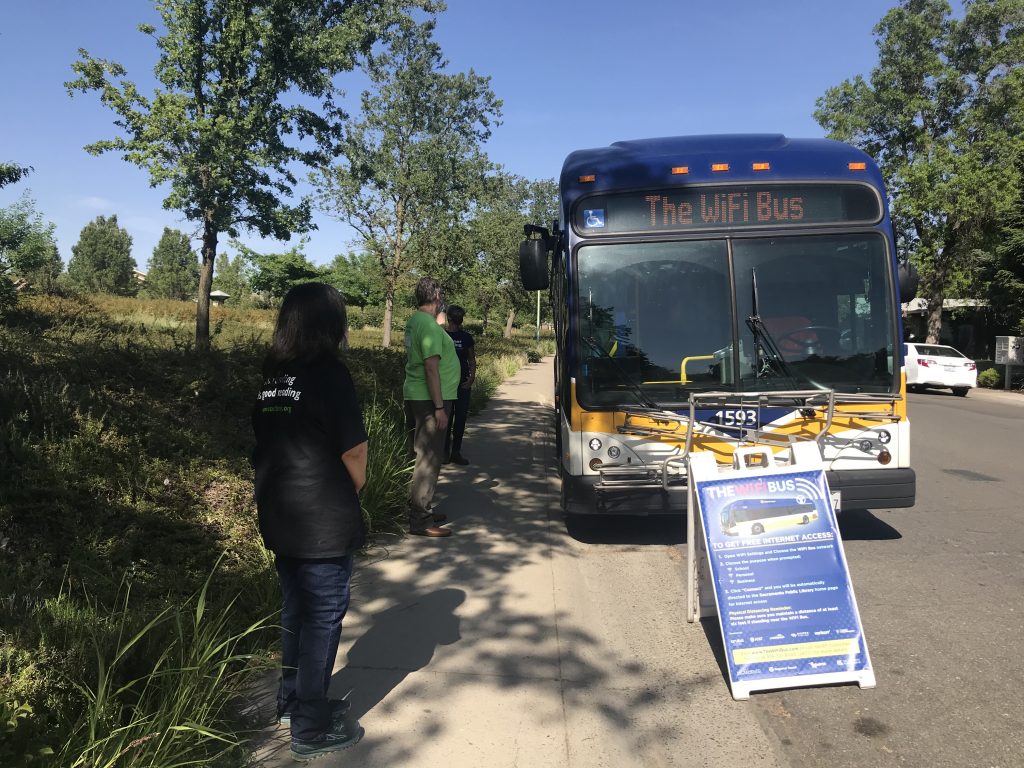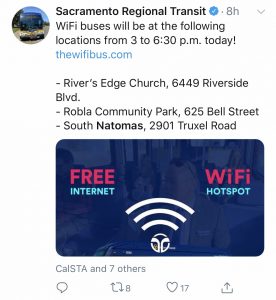BY BRANDY TUZON BOYD
THE NATOMAS BUZZ | @natomasbuzz
A Wi-Fi bus designed to bridge the digital divide hit some bumps in the road as it rolled into South Natomas on Thursday.
Sacramento Regional Transit has teamed up with the California State Transportation Agency and the City of Sacramento to equip buses as wireless hot spots and place them in communities with limited high-speed internet access during the COVID-19 pandemic. The goal of the free service is to support distance learning.
Testing for the concept started May 1 and the first three hot spots went live this week in Sacramento on May 4.
The first bus deployed in Natomas was scheduled to be parked at the South Natomas Library at 2901 Truxel Road from 3 p.m. to 6:30 p.m. on Thursday. But after 90 minutes, and 90-degree temperatures, no bus had arrived.
The Sacramento Public Library is providing bus parking at its branches and library staff are equipped to set up six-foot tables with chairs and pop ups to provide shade for Wi-Fi users. Staff added that they are there to encourage social distancing practices as well as sanitize the work spaces between uses. The tables, they said, are marked to ensure users maintain six-feet distance.
But after more than an hour of phone calls and text messages between library staff and Deputy Director Jerrid Keller, it turned out that instead of parking at the library as planned, the Wi-Fi bus was stationed a quarter-mile or so away on Bannon Creek Drive, adjacent to the South Natomas Community Park playground. It did not appear any students were in the vicinity to use the bus Wi-Fi and library staff was unable to set up due to its location.
The city’s Chief Innovation Officer Louis Stewart admitted the fast-moving Wi-Fi bus project hit a snag earlier in the week, after sites had been located and already publicized to the public.
“…We have been made aware that we need to get right-of-entry agreements for buses to park in parking lots so that’s what we are currently working to do at all the sites we are working with,” Stewart said.
These agreements, he explained, are needed with school districts, libraries and churches — anywhere the buses are parked. The goal, he added, is to have all needed agreements in place before the program deploys seven additional buses next week on May 11.
Sacramento Vice Mayor Jeff Harris, who represents most of South Natomas on the city council and also a member of the Regional Transit board, said he was excited about the Wi-Fi buses.
“Unfortunately, we had a tiny setback,” Harris said. “I’m sure we’ll get past this pretty quickly.”
The driver of the Wi-Fi bus parked in the Grant High School parking lot Thursday morning reported a steady flow of participants. Twin Rivers Unified School District had opened Grant’s auditorium for those wishing to access the Wi-Fi.
The 10 Wi-Fi buses are outfitted with combinations of equipment provided free of charge by project partners: Aruba, AT&T, Cradlepoint, Sierra Wireless, T-Mobile and Verizon Wireless which offer free high-speed connectivity up to 1,800 feet. Each bus is scheduled to provide 3-½ hours hours of wireless broadband service at two locations each day, for a total of 140 locations each week.
According to Regional Transit, high-need locations are selected with input from local school districts, community organizations and digital divide research, as well as the ability for users to maintain physical distancing.
Gov. Gavin Newsom announced the Wi-Fi bus project on April 20 as part of the state’s efforts to support distance learning and close the digital divide during the COVID-19 pandemic. About one in five students in California lack high-speed internet access and nearly half of all low-income households in the state do not have broadband service at home.





Speak Your Mind
You must be logged in to post a comment.